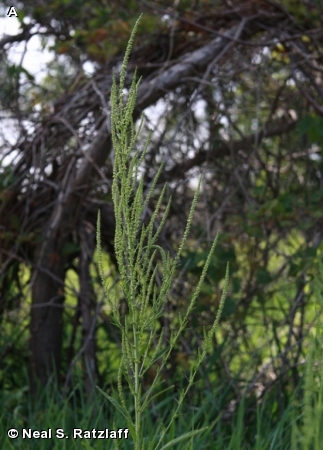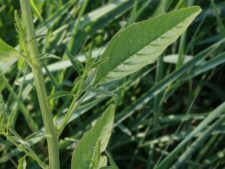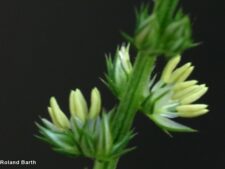
WATER HEMP
Amaranthus tuberculatus
AMARANTH FAMILY (Amaranthaceae)
 Identification
Identification
- Flowering time - July to October
- Uncommon in wet areas at FF & NW
- Tall plant with slender greenish flower spikes
- Hairless, alternate lance-shaped leaves
- Male & female flowers on separate plants
This tall weedy species was common on the floodplain of Fontenelle Forest in 2012, the year after the big flood. It was identified with the help of biology professors Kaul and Sutherland. It can be tall (up to 6 feet) and slender (A), or tall and spreading. Alternate, hairless, lance-shaped leaves on long stalks have smooth slightly wavy margins (B). The tiny (1/8 inch) male and female flowers are found on separate plants (dioecious) and have no petals. The yellow stamens first emerge as in image (C), then change in appearance as shown in image (D). The white stigmas are shown on female flowers in image (E).
This species was abundant on the floodplain in 2012, the year after the big flood. The author has not observed it since, probably because he has not looked for it and/or it was overlooked. It is likely in wet areas, particularly pond or stream edges, at both Fontenelle Forest and Neale Woods. Flowering occurs from July to October.
Plants in the Amaranth genus, better known by the alternate name “pigweed” are widespread in disturbed habitats in our area. Water Hemp, closely related Palmer’s Pigweed (A. palmieri) and their hybrids, many of them resistant to herbicides, are among our most serious agricultural weeds. “Tumbleweeds” (Amaranthus albus), a plant more common to the west, is also a member of this genus.
Plants in this genus are among the most difficult to ID because minute technical characterstics that separate them and their many hybrids. Water Hemp is one of only a few pigweeds with separate male and female flowers separating it from most of our local pigweeds except for Palmer’s Pigweed (A. palmieri). It is generally taller and has longer, more slender flower spikes than our other local pigweed species.
The content of NatureSearch is provided by dedicated volunteer Naturalists of Fontenelle Forest who strive to provide the most accurate information available. Contributors of the images retain their copyrights. The point of contact for this page is: Roland Barth.




